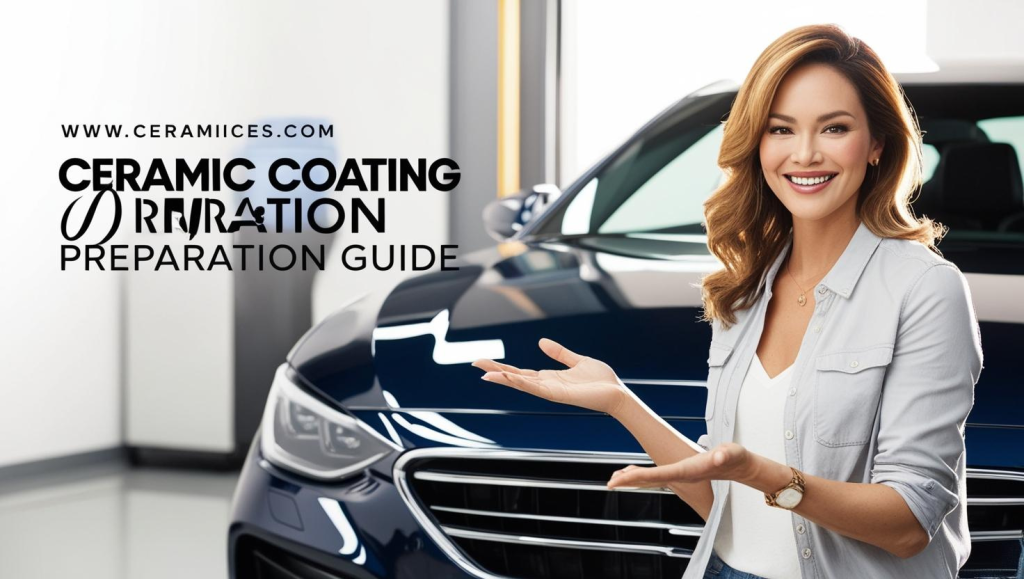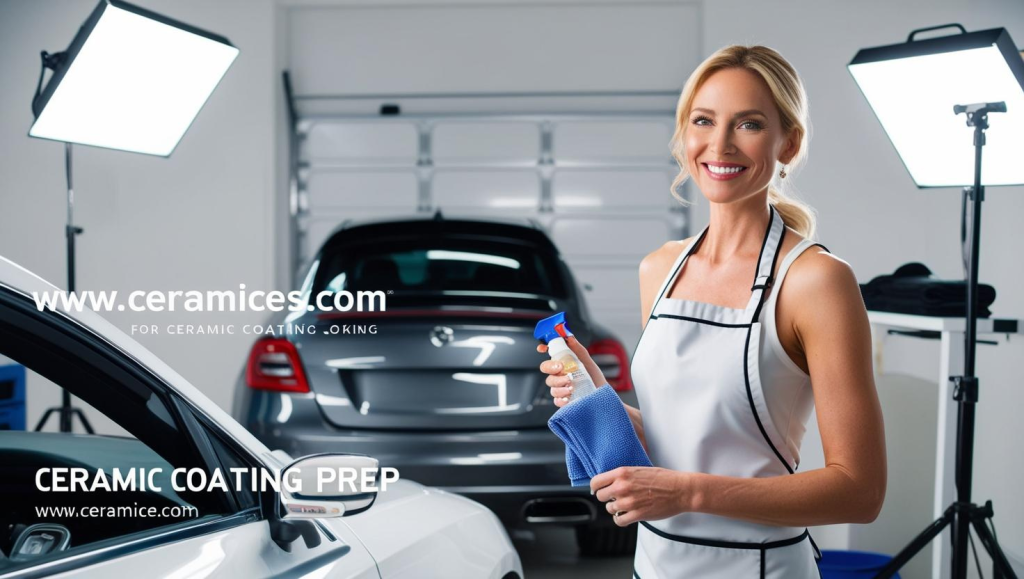Ceramic coating has become a popular choice for protecting and enhancing the appearance of vehicles, offering long-lasting durability and a high-gloss finish. However, the key to achieving the best results lies in proper preparation. If you’re wondering, “How to prepare for ceramic coating?”, this guide will walk you through the process step-by-step, provide tips for ensuring a flawless finish, and answer frequently asked questions. By the end of this article, you’ll have all the knowledge you need to prepare your vehicle for ceramic coating like a pro.
Why Prepare for Ceramic Coating?
Proper preparation is essential for ensuring the ceramic coating adheres correctly and performs as intended. Skipping or rushing the preparation process can lead to:
- Poor Adhesion: The coating may not bond properly, leading to premature failure.
- Imperfections: Dirt, scratches, or swirl marks can become trapped under the coating.
- Reduced Durability: A poorly prepared surface can compromise the coating’s longevity and effectiveness.
- Wasted Time and Money: Without proper preparation, you may need to redo the coating, costing you time and resources.
How to Prepare for Ceramic Coating: Step-by-Step Guide

1. Gather Your Supplies
Before starting, ensure you have the following tools and materials:
- Car wash soap (pH-neutral)
- Clay bar or clay mitt
- Iron remover (for decontamination)
- Polishing compound and polishing pads
- Dual-action polisher (optional, for machine polishing)
- Microfiber towels
- Isopropyl alcohol (for final surface preparation)
- Masking tape (to protect sensitive areas)
- Protective gear (gloves, goggles, and mask)
2. Wash the Vehicle Thoroughly
- Rinse the Vehicle: Use a hose to remove loose dirt and debris.
- Apply Car Wash Soap: Use a pH-neutral car wash soap and a microfiber wash mitt to clean the vehicle thoroughly.
- Rinse and Dry: Rinse off the soap and dry the vehicle with clean microfiber towels.
3. Decontaminate the Surface
- Apply Iron Remover: Spray an iron remover over the vehicle’s surface to dissolve metal particles and brake dust.
- Rinse and Dry: Rinse off the iron remover and dry the vehicle.
4. Clay Bar Treatment
- Lubricate the Surface: Use a clay lubricant or quick detailer to lubricate the surface.
- Clay the Vehicle: Gently glide the clay bar or clay mitt over the surface to remove embedded contaminants.
- Wipe and Inspect: Wipe the surface with a microfiber towel and inspect for smoothness.
5. Polish the Surface
- Choose the Right Polishing Compound: Select a compound that matches the level of correction needed (light, medium, or heavy).
- Polish by Hand or Machine: Use a dual-action polisher for machine polishing or apply the compound by hand for smaller areas.
- Work in Sections: Polish the vehicle in small sections, ensuring even coverage and consistent results.
- Wipe Off Residue: Use a clean microfiber towel to remove polishing residue.
6. Final Surface Preparation
- Wipe with Isopropyl Alcohol: Mix isopropyl alcohol with water (1:1 ratio) and wipe the surface to remove any remaining oils or residues.
- Inspect the Surface: Ensure the surface is clean, smooth, and free of imperfections.
7. Mask Off Sensitive Areas
- Protect Trim and Edges: Use masking tape to cover areas like rubber trim, plastic parts, and edges to prevent accidental coating application.
8. Apply the Ceramic Coating
- Follow Manufacturer Instructions: Apply the ceramic coating according to the manufacturer’s guidelines, working in small sections.
- Use Applicator Pads: Apply the coating evenly using foam or microfiber applicator pads.
- Buff Off Excess: After the coating flashes (hazes), use a clean microfiber towel to buff off the excess.
9. Cure the Coating
- Allow to Cure: Let the coating cure for the recommended time, typically 24-48 hours, before exposing the vehicle to moisture or dirt.
Tips for Preparing for Ceramic Coating

- Work in a Clean Environment: Ensure your workspace is clean and free of dust to avoid contamination.
- Use High-Quality Products: Invest in good-quality cleaning and polishing products for better results.
- Take Your Time: Rushing the preparation process can lead to mistakes and imperfections.
- Follow Manufacturer Guidelines: Always refer to the ceramic coating manufacturer’s instructions for best practices.
- Protect Yourself: Wear protective gear to avoid exposure to chemicals and dust.
Common Mistakes to Avoid When Preparing for Ceramic Coating
- Skipping Decontamination: Failing to remove contaminants can lead to poor adhesion and trapped imperfections.
- Ignoring Polishing: Polishing ensures a smooth surface and enhances the coating’s effectiveness.
- Using the Wrong Products: Avoid using harsh chemicals or abrasive tools that can damage the paint.
- Rushing the Process: Proper preparation takes time and attention to detail.
How to Prepare for Ceramic Coating Naturally
If you prefer eco-friendly methods, choose biodegradable cleaning products and avoid harsh chemicals. Use water-based polishes and coatings to minimize environmental impact.
FAQs About Preparing for Ceramic Coating
1. How long does it take to prepare a vehicle for ceramic coating?
Preparation can take several hours to a full day, depending on the vehicle’s condition and size.
2. Can I apply ceramic coating without polishing?
Polishing is recommended to remove imperfections and ensure a smooth surface for the coating.
3. Do I need to decontaminate the surface before coating?
Yes, decontamination removes embedded contaminants that can affect the coating’s adhesion.
4. What is the best way to remove swirl marks before coating?
Use a dual-action polisher with a suitable polishing compound to remove swirl marks effectively.
5. Can I prepare my vehicle for ceramic coating at home?
Yes, with the right tools and products, you can prepare your vehicle for ceramic coating at home.
6. How do I know if my vehicle is ready for ceramic coating?
The surface should be clean, smooth, and free of contaminants, scratches, and swirl marks.
7. What should I avoid before applying ceramic coating?
Avoid waxing, sealing, or using silicone-based products, as they can interfere with the coating’s adhesion.
8. How often should I prepare my vehicle for ceramic coating?
Preparation is needed only before the initial application. Regular maintenance will extend the coating’s lifespan.
9. Can I apply ceramic coating in cold or humid conditions?
Avoid applying the coating in extreme temperatures or high humidity, as it can affect the curing process.
10. How do I maintain my vehicle after ceramic coating?
Wash the vehicle regularly with pH-neutral soap and avoid abrasive cleaners or tools.
Additional Tips for Maintaining a Ceramic-Coated Vehicle
1. Regular Washing
Wash the vehicle regularly to remove dirt and contaminants that can degrade the coating.
2. Use a Ceramic Coating Maintenance Spray
Apply a maintenance spray periodically to enhance the coating’s durability and gloss.
3. Avoid Automatic Car Washes
Automatic car washes can use harsh chemicals and brushes that damage the coating.
4. Inspect for Damage
Regularly inspect the coating for signs of wear or damage and address any issues promptly.
5. Park in the Shade
Parking in the shade or using a car cover can protect the coating from UV rays and environmental contaminants.
The Benefits of Ceramic Coating
1. Long-Lasting Protection
Ceramic coating provides durable protection against UV rays, oxidation, and environmental contaminants.
2. Enhanced Gloss
The coating enhances the vehicle’s shine, giving it a showroom-quality finish.
3. Ease of Maintenance
A ceramic-coated vehicle is easier to clean and maintain, as dirt and water bead off the surface.
4. Cost-Effective
While the initial cost may be high, the long-term benefits and reduced need for frequent waxing make it cost-effective.
Conclusion
Learning how to prepare for ceramic coating is essential for achieving a flawless and long-lasting finish. By following the steps outlined in this guide, you can ensure your vehicle is ready for the coating and enjoy the benefits of enhanced protection and appearance. Whether you’re a car enthusiast or a first-time user, proper preparation is the key to unlocking the full potential of ceramic coating.
So, the next time you’re considering ceramic coating for your vehicle, remember the tips and techniques shared in this guide. With a little preparation and care, you can enjoy the benefits of a beautifully coated vehicle for years to come. Happy coating!
This extended guide provides a deeper dive into the world of ceramic coating preparation, offering additional tips, benefits, and insights to help you handle the process with confidence. Whether you’re coating a car, motorcycle, or other vehicle, this comprehensive guide has everything you need to know about preparing for ceramic coating.